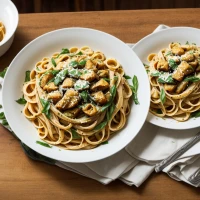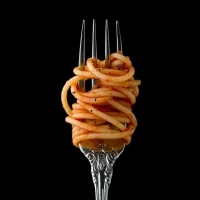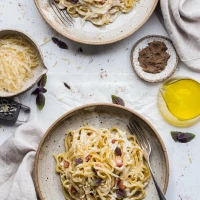Authentic cacio e pepe is not merely a dish; it’s an Italian cultural artifact, a delightful manifestation of culinary simplicity that requires just the right balance of its namesake ingredients – cheese (cacio) and black pepper (pepe). This pasta dish, with roots nestled in the antique culinary traditions of Rome, has found its way into the hearts of gourmands worldwide, becoming a beloved classic. With an emphasis on quality and technique over complexity, authentic cacio e pepe recipe has become a testament to the aphorism that less is indeed more. It’s a luscious meld of al dente spaghetti, aged Pecorino Romano cheese, and a bold kiss of freshly cracked black pepper that creates a vegetable-free feast of flavors, offering the comforts of Italian cuisine right in your kitchen.
In this comprehensive guide, we dive deep into the art of creating the perfect authentic cacio e pepe to savor and celebrate the richness of Italy’s simplest pasta delight. Brace your taste buds for an appetizing journey!
Discovering Cacio e Pepe: A Brief History
Before we delve inhow long to let brisket rest the nuances of crafting the perfect cacio e pepe, let’s take a moment to appreciate its history. Originating as a shepherd’s meal in the Apennine hills of Italy, cacio e pepe is a testament to the ingenuity of using limited, transportable ingredients to create a satisfying dish. To truly understand and respect this dish, one must recognize the value of its ancient simplicity.
The Quintessential Ingredients
- Pasta: Traditionally, spaghetti or tonnarelli are used for their ability to hold the sauce well.
- Cheese: Pecorino Romano, a hard, salty sheep’s milk cheese, is the star that adds depth and creaminess.
- Black Pepper: Freshly ground, it imparts a warm and aromatic essence that impeccably seasons the dish.
Preparing the Foundations: Selecting Your Ingredients
A spellbinding authentic cacio e pepe recipe hinges on the premium quality of a few key ingredients. Their synergy is fundamental in capturing the essence of this Roman marvel.
The Ideal Pasta
Spaghetti is the most commonly used pasta for cacio e pepe, although tonnarelli or bucatini may also make excellent choices. The goal is to choose a pasta that has sufficient surface area and texture to enrobe itself in the luscious sauce.
Selecting the Right Cheese
Pecorino Romano is non-negotiable. Look for a well-aged variety, as its nutty and tangy profile is absolutely critical. A younger cheese might lack the necessary punch the dish demands.
The Peppercorn Predicament
Black pepper is more than just a seasoning in cacio e pepe – it’s a core component. Opt for a high-quality whole black peppercorn, which you’ll toast and crush right before melding it into the dish.
Step-by-Step: Assembling Your Cacio e Pepe
Mastering this deceptively simple dish requires patience and attentiveness. Be prepared to invest both as you follow these steps closely.
1. Cooking the Pasta
Bring a large pot of water to a boil and season it with salt until it tastes like the sea. Add in your spaghetti and cook it until it is just al dente. Always keep a cup of the pasta cooking water before draining – this starchy liquid is golden when it comes to achieving the emulsification of your sauce.
2. Toasting the Peppercorns
In a separate pan, toast the whole black peppercorns until fragrant. Then, crush them coarsely, awakening their spicy fragrance and setting the stage for their starring role.
3. Creating the Emulsion
This is where the magic happens. Combine the hot pasta, a generous handful of grated Pecorino Romano, and the black pepper in a warm bowl. Add in a splash of the pasta water and begin tossing the ingredients vigorously together. The goal is to smoke eater for homem a glossy, smoothly emulsified sauce that clings to each strand of pasta without becoming clumpy or grainy.
The Trouble with Temperature
Controlling the temperature is where many go wrong. Too much heat and the cheese will seize; too little, and the sauce won’t form. Aim for a happy medium, and use the residual heat from the pasta to your advantage.
The Ratio Game
Balancing the cheese and pasta water can be more art than science. You want enough liquid to form a sauce, but not so much that it dilutes the punchy cheese.
Fine-Tuning Your Technique
To turn your cacio e pepe from good to sublime, consider these additional tips.
The Cheese Barrier
Some swear by the trick of adding a thin layer of grated cheese at the bottom of the serving bowl before introducing the pasta, as it helps kick-start the emulsification process.
The Swirl and Whip
As you toss the pasta with the cheese and water, be as thorough and as vigorous as you can. This aerates the mixture, contributing to the creaminess of the sauce.
The Final Seasoning
After you’ve achieved the perfect sauce consistency, give a final taste. The cheese is salty, so you may not need additional salt, but an extra crack of black pepper can add those last touches of aromatic zest.
Serving Suggestions: Elevating Your Cacio e Pepe
While authentic cacio e pepe stands firmly on its own, there’s always room for creativity in presentation.
The Right Bowl
Serve your cacio e pepe in a pre-warmed pasta bowl. The warmth of the bowl will prevent your sauce from cooling down and solidifying too quickly.
Garnish Wisely
A modest sprig of fresh parsley or a final flirtatious grating of Pecorino can add both color and a touch of refinement.
Pairings and Combinations
Even though vegetables don’t traditionally accompany this dish, modern interpretations occasionally incorporate sautéed greens or a peppery arugula salad to add a fresh contrast.
Beverage Pairings
A crisp, dry, white wine such as Frascati, made from grapes of the Roman hills, complements the rich flavors wonderfully.
Side Dishes
If looking to add a side, consider a simple side salad or steamed vegetables, lightly seasoned, to balance the indulgence of the pasta.
The Vegetarian’s Delight: Cacio e Pepe’s Hidden Advantage
Despite its simplicity, or perhaps because of it, cacio e pepe is a vegetarian’s dream when it comes to authentically Italian, vegetable-free dishes. As more diners seek meatless options, it stands as a proud testament to the versatility and timeless appeal of traditional Italian cuisine.
The Health Perspective
While the buttery cheese in an authentic cacio e pepe recipe might raise nutritional eyebrows, when consumed in moderation, the dish can slip into a balanced diet. Incorporating a side of vibrant, fiber-rich vegetables can round out the meal nutritiously.
Frequently Asked Questions (FAQs)
In closing, here are some quick answers to common queries about making cacio e pepe:
Can I Use a Different Type of Cheese?
Ideally, no. Pecorino Romano offers a unique flavor profile essential to an authentic cacio e pepe recipe.
Can I Make Cacio e Pepe Gluten-Free?
Certainly! Just substitute regular pasta with your favorite gluten-free brand. Keep in mind that different pasta varieties may affect the final taste and texture.
How Do I Prevent the Cheese from Clumping?
Temperature moderation and constant, brisk stirring are key. The starchy pasta water also helps, so don’t be shy with it.
Can I Store Leftover Cacio e Pepe?
While best enjoyed fresh, leftovers can be refrigerated. Gently reheat them over low heat with a touch of water to loosen the sauce.
The Last Forkful: Reflections on a Timeless Classic
The beauty of authentic cacio e pepe lies in its harmony of elemental flavors – generous cheese, bold black pepper, and the humble wheat of pasta – which transcend their simplicity to deliver a luxurious reprieve from the everyday. It is Italian comfort on a fork; a moment captured, a whisper from Rome’s ancient streets savored in each twirl and bite.
Now, brimming with knowledge and armed with the secrets to crafting an authentic cacio e pepe recipe, you are ready to bring a piece of Italy into your home. From the careful selection of a few elite ingredients to the mastery of technique, every step taken brings you closer to savoring Italy’s simplest pasta delight. Buon Appetito!










